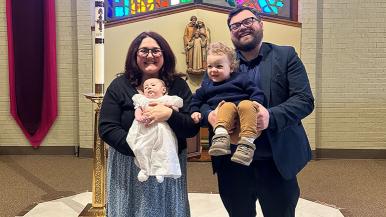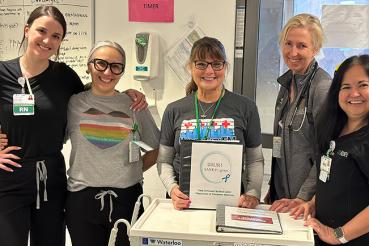Imagine being eight months pregnant and struggling to breathe. Now imagine being told that your airway is as narrow as a straw and you need a procedure immediately — and that when you come out of anesthesia, your child may have already delivered under emergency C-section.
That was the case for Hannah Culver. She was five months pregnant with her second child, when she noticed she was having serious breathing issues.
“I would be out of breath just walking down the hallway at work,” Hannah says. “To the point where my coworkers started asking if I was OK.”
Hannah works in health care and knew something was different with this pregnancy. At eight months pregnant, she went into a day of doctors’ appointments with her health care team in Indiana — ready to explain her symptoms. But she wasn’t anticipating just how quickly things would change.
Nov. 15: Diagnosis and mobilization
Hannah’s first appointment: the otolaryngologist. Her provider was able to confirm her shortness of breath wasn’t being caused by asthma — something Hannah thought she’d had since childhood. But it didn’t have anything to do with her lungs at all. It was her airway.
Hannah’s airway was only 4 millimeters wide — about the width of a drinking straw. A normal airway should be three times as wide. They diagnosed her with idiopathic subglottic stenosis, a condition where someone’s airway narrows without a clear cause or trigger.
The treatment for idiopathic subglottic stenosis is an outpatient procedure to widen the airway. But since Hannah was far along in her pregnancy, the procedure — which involves anesthesia — posed a risk to her and her baby.
Hannah’s doctors in Indiana didn’t have the type of resources needed for her complex situation, to ensure her and her child’s safety, so they contacted a colleague at RUSH.
That colleague was James Katsis, MD, an interventional pulmonologist. On the call, Hannah’s otolaryngologist explained the situation to Katsis, who said he was confident he could get the procedure done — but Hannah would need to come in that same night.
“After I got off the phone with Hannah’s doctor, I called Hannah and it was very obvious she was very symptomatic with shortness of breath and loud breathing,” says Katsis. “When you have a patient who is pregnant, respiratory compromise isn’t just dangerous for them, but also for the baby. So we wanted to take a more aggressive approach to her care and to make sure she was seen as soon as possible.”
“When they finally gave me the diagnosis, it kind of made sense,” Hannah says. “I thought ‘Oh, my throat is closing,’ but up until that point I had no clue it was that severe."
Hannah got off the phone and headed from her home in Munster, Indiana, to RUSH University Medical Center in Chicago. She was admitted to the ICU, where she and her baby were monitored overnight.
Nov. 16: Procedure day
The next morning is a blur for Hannah. Doctors from different departments were coming in to check on her and prepare her for the procedure. As a health care provider herself, Hannah is used to the whirl of a procedure room. But when she was wheeled into the room on the other end of it — this time as a patient — reality started to sink in.
“I remember getting wheeled in and feeling anxious. It was the most doctors I’ve ever seen in one place in my life,” Hannah says. “I remember thinking about my 2-year-old son, feeling so scared for him if something would’ve gone wrong, or how he would feel if I came out of the procedure with something coming out of my neck to support my breathing, or if I came home and his sister’s not in my belly anymore.”
Prep for the procedure went quickly. In addition to preparing Hannah for the airway widening procedure, the obstetrics team was also preemptively preparing her for a C-section in case the baby ended up being in distress and needed to be taken care of outside the womb.
“Our team at RUSH were ready for an emergency, including needing to deliver the baby prematurely in order to save the mother and the baby,” Anna McCormick, DO, says. “We were set up to monitor the baby's heart rate very closely during the procedure as well as the mom's vital signs in order to optimize blood flow to the uterus to ensure Hannah and her baby stayed safe."
Fresh air
The next thing Hannah remembers is being put back into her bed in the ICU after the procedure. Doctors told her and her husband that everything went well. Katsis and his team were able to widen her airway from 4 millimeters to 12. Her baby did well during the procedure, and the obstetrics team didn’t have to deliver the baby in an emergency C-section.
For the first time, Hannah started to realize how her breathing had changed.
“I felt so much relief. I thought, ‘Oh my God this is what normal people breathe like?’” Hannah says. “I couldn’t remember how long it’d been since I could breathe like that."
After another night in the hospital for monitoring, Hannah was able to go home.
Less than a month after the procedure at RUSH, Hannah gave birth to her baby girl, Kiera, in Indiana without complications.
Now, Hannah is keeping an eye on her breathing and is getting regular check-ins to see how much her airway has narrowed. Since idiopathic subglottic stenosis is a persistent condition, she, like the thousands of others with the condition, will need to undergo airway widening procedures for the rest of her life.
Hannah also feels comforted to know what to look out for as her daughter grows up — since the condition is most commonly found in women and could potentially be passed down.
“I’m definitely glad I know what to expect in the future, so if my daughter starts showing signs, I’ll know what it is. It makes me feel a little bit better that I know what I’m looking at now.”




